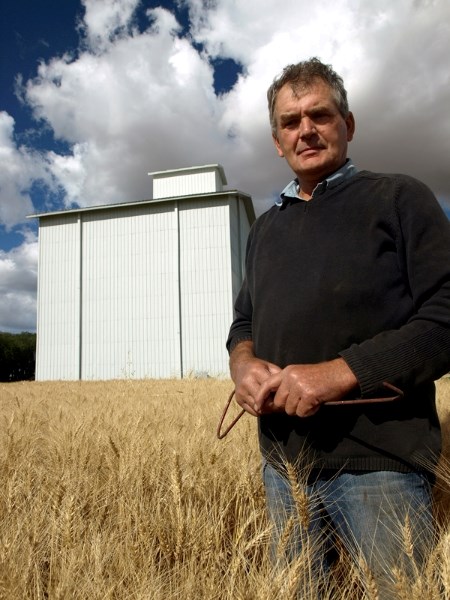When Raymond Dodd was a boy he and his brothers would mischievously sneak into the old grain elevator on their home property at the famed Reed Ranch. They didn't want their parents to see them because what they were about to do was something that was frowned upon.Careful not to be noticed they quietly climbed the stairs inside and went to the very top. From there the world opened up.ìIt was something we were not supposed to do but my brothers and I used to play around and climb to the top. We would look around at the whole countryside. We thought it was quite the height,î said Dodd. ìThere were a lot of happy memories in that old elevator.îThese joyous and memorable moments for the Dodd boys were forever etched in time more than 60 years ago. The Dodd family acquired the property and elevator in 1938. They left 20 years later. In 1959, it was purchased by the MacDonald family.And then in 1996 the land was purchased by the family of Roelof Speelman, a farmer who came to Canada with his wife Eltien and son Eduard from the Netherlands. They too felt there was something special about the elevator.ìI like it. It is history from this area. Most elevators were by the railroad. Not many were on the farms,î said Roelof, who at the age of 70 still owns 1,260 acres of prime grain land on the former Reed Ranch.What is truly remarkable about the Reed Ranch structure is that it could well be the oldest remaining grain elevator ñ primary or private - still standing in Alberta. Most of the province's primary corporate grain elevators built along the railroad have been demolished over the past 25 years (in 1934, the number of primary elevators in Alberta peaked at 1,755; today there are less than 120). The oldest primary grain elevator still standing in the province is an Alberta Pacific model in Raley. It was built in 1905.However, Eduard's research reveals the stout Reed Ranch grain elevator was built two years earlier.ìIt was in 1903 that I was told. I have tried to get information to confirm it. But that is what neighbours and former owners have told me. There is no way of finding out for certain. The county does not have the records to show that,î said Eduard, who has spent countless hours researching the history of the elevator, and many more restoring it since his arrival to Canada with his family.However, there is no doubt the Reed Ranch, located on the north side of Hwy. 27 about 16 kilometres east of Olds, made an important mark on Olds area history. More than any other dream of the early 20th century era it represented the ultimate pioneer dream of prosperity in a new untamed land that teemed with unlimited potential.In 1901, entrepreneurs from Iowa purchased 22 sections of land east of Olds at a price of $4.10 an acre, including what became known as the Reed Ranch. Businessman J.W. Reed took over responsibility of the newly formed Baxter and Reed Cattle Company. The venture soon developed quickly. More than 1,000 two-year-old cows were shipped in from Texas. As well, the ranch saw scores of prized purebred Hereford cows, imported from Kansas. In 1904 purebred Belgian mares were brought to the ranch. Three years later it was the home to prized Hackney mares.By 1911 the Reed Ranch has more than 5,000 head of grade cattle, 125 head of purebred cattle and 350 horses. What was equally impressive was the $75,000 spent by the owners for capital improvements, including the largest barns for livestock ever seen in that era, and a grain elevator.In the first six years of operation (1902-08), wrote local historian Bodil Jensen in 1965 for the County of Mountain View history book, the Reed Ranch had barns for 150 horses and an elevator ìwhich had and to this dayî has a storage capacity of 40,000 bushels and a milling operation capacity that could grind 1,200 bushels of chop a day.By 1928 Reed and his company had dissolved and the ranch was sold into small holdings. While Jensen's account of the elevator's origins is not absolute proof of its exact age it was enough to convince the Speelmans the structure was worth saving.The elevator was in bad shape when the family took over the farm in 1996. Eduard painstakingly researched the possibility of obtaining provincial heritage funding and historical status for the structure but the guidelines proved too onerous. The family went ahead without government support and spent up to $25,000 and committed countless hours to repair the structure back to full working order.They strengthened the interior with new rods in the elevator's upper areas, allowing them to utilize the structure's full capacity. The base was fixed with new concrete footings. Rotten wood in the flooring was dug out and replaced. A new external tin siding was installed.ìIt was an eyesore. Now it is beautiful,î said Eduard, who left his parent's farm with wife Audrey six years to work his own 4,000-acre farm 10 kilometres southeast. ìWe still have to finish siding on the northeast side. We have the time for it.îAnd so does Raymond Dodd. He is happy to regale anyone with his childhood memories of the old Reed Ranch grain elevator. For him the ancient structure represents everything that was pure and good about the Olds region's pioneer days. He is grateful to the Speelmans for their effort and dedication.ìI admire them for doing that. I am so happy they spent the money to fix it up,î said, who still farms in the Olds area. ìWe grew up there. It was quite a place at one time.î



